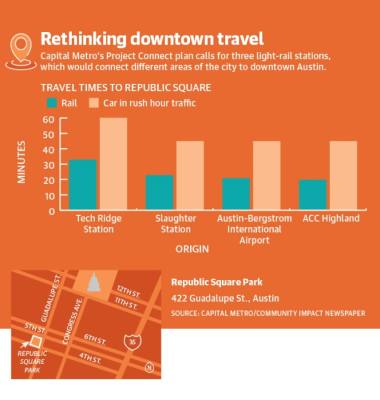The $9.8 billion plan would add three light-rail lines. One, the Orange Line, would run between Tech Ridge in North Austin to Slaughter Lane in South Austin. Another, the Blue Line, would connect downtown Austin to the Austin-Bergstrom International Airport, and the third, the Gold Line, would run between Austin Community College’s Highland campus and South Austin.
The lines outlined in the plan would run through an underground tunnel downtown to take them away from traffic, and they would converge in some denser sections of the city to provide service every five minutes rather than every 10 minutes, according to Project Connect program manager Dave Couch.
Now that Project Connect has been adopted, a major next step for local officials will be working out the financing aspect.
According to a presentation from Jill Jaworski of PFM Financial Advisors to the board and City Council on June 10, analysis of other projects around the country support an estimate that 45% of Project Connect would be funded by the federal government—or $4.4 billion of the $9.8 billion project.
That leaves $5.4 billion to be funded locally, which would come in part from property taxes. In August, once the city and Capital Metro board determine how much revenue is needed and where the city would need to set the tax rate, City Council could call for a tax rate election, which would ask voters for permission to raise property taxes to bring in the revenue needed to fund the program.
Those numbers still need to be finalized, but on June 10 Jaworski and Greg Canally, Austin’s deputy chief financial officer, presented numbers based on an $0.11 increase in the tax rate per $100 of home valuation. For the median homeowner of a $325,000 property, that would translate to a $358 increase annually.
Both the city and Capital Metro will next be going to their annual budget reviews in July. Austin City Council has until Aug. 12 to call a referendum, and then the decision would go to the voters in November.
Read the full story here.
ONGOING PROJECTS
RM 222 bypass and improvementsTexas Department of Transportation crews installed a storm sewer underneath the intersection of RM 620 and RM 2222 in May.
Timeline: fall 2018-late 2021
I-35 flyover construction
In May, TxDOT crews set beams on southbound I-35 to southbound US 183 flyover.
Timeline: January 2018-mid-2021
North Lamar Boulevard Improvements
Lane closures along North Lamar Boulevard from US 183 to Payton Gin Road have begun as city of Austin crews improve multiple intersections.
Timeline: spring 2020-fall 2020






